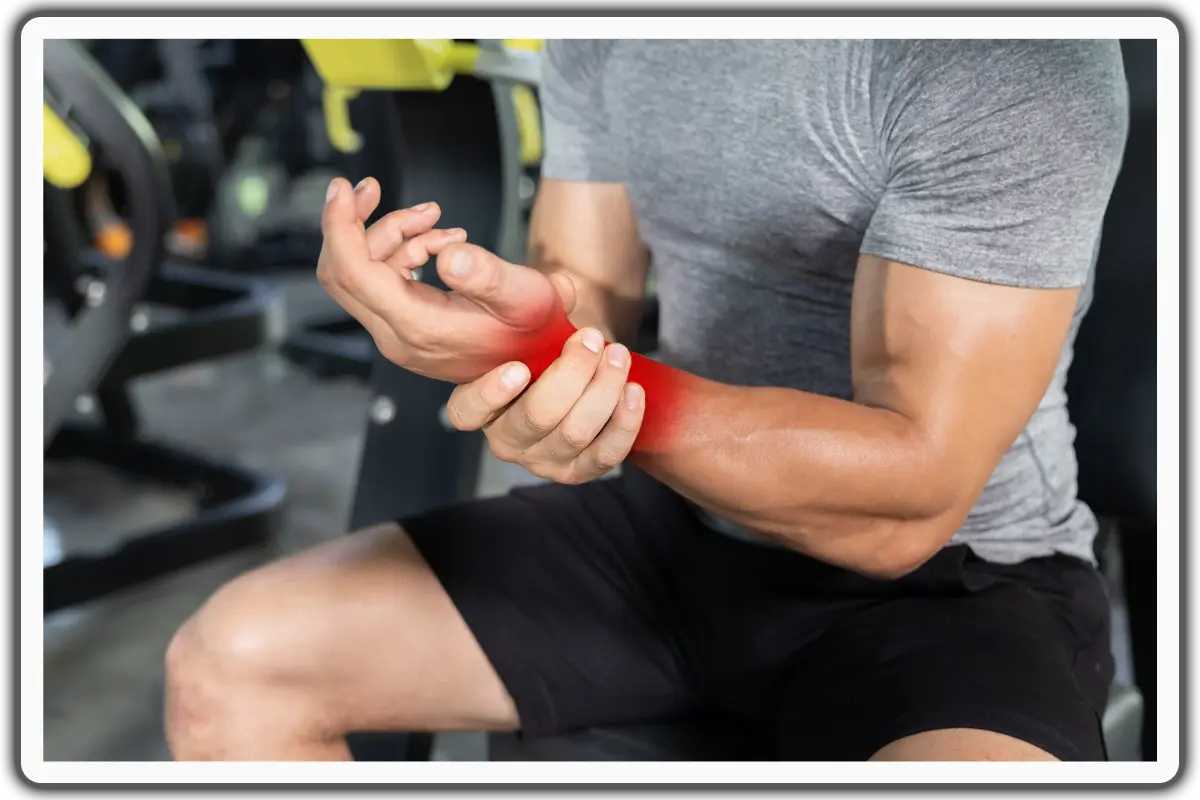
Ease Your Wrist Pain: Essential Exercises for Wrist Pain Management
Weightlifting is a great way to get stronger and build stamina. However, it can also cause wrist pain, which nobody wants. In this article, we will explore why weightlifters often experience wrist pain. We'll look at the usual reasons behind this discomfort.
To help you out, we'll introduce four exercises that reduce wrist pain. These exercises are not only about easing the pain but also about making your wrists stronger. Following this article's advice, you can continue lifting weights while keeping your wrists healthy and pain-free.
Understanding Wrist Structure
The wrist is an amazing part of your body, consisting of eight little bones in two rows. It also has many ligaments, tendons, and muscles that work together to move your wrist in many ways. This is important for doing lots of things, like lifting weights. Each bone in the wrist connects to the bones next to it, which lets your wrist move smoothly and be strong.
Ligaments are like strong bands that hold the bones together, tendons are like cords that attach your muscles to the bones, and muscles make your wrist move. These parts also help your wrist handle the force when you lift something heavy. Knowing how your wrist works helps you understand why it can hurt sometimes and how doing certain exercises for wrist pain can keep your wrist healthy.
Common Wrist Conditions
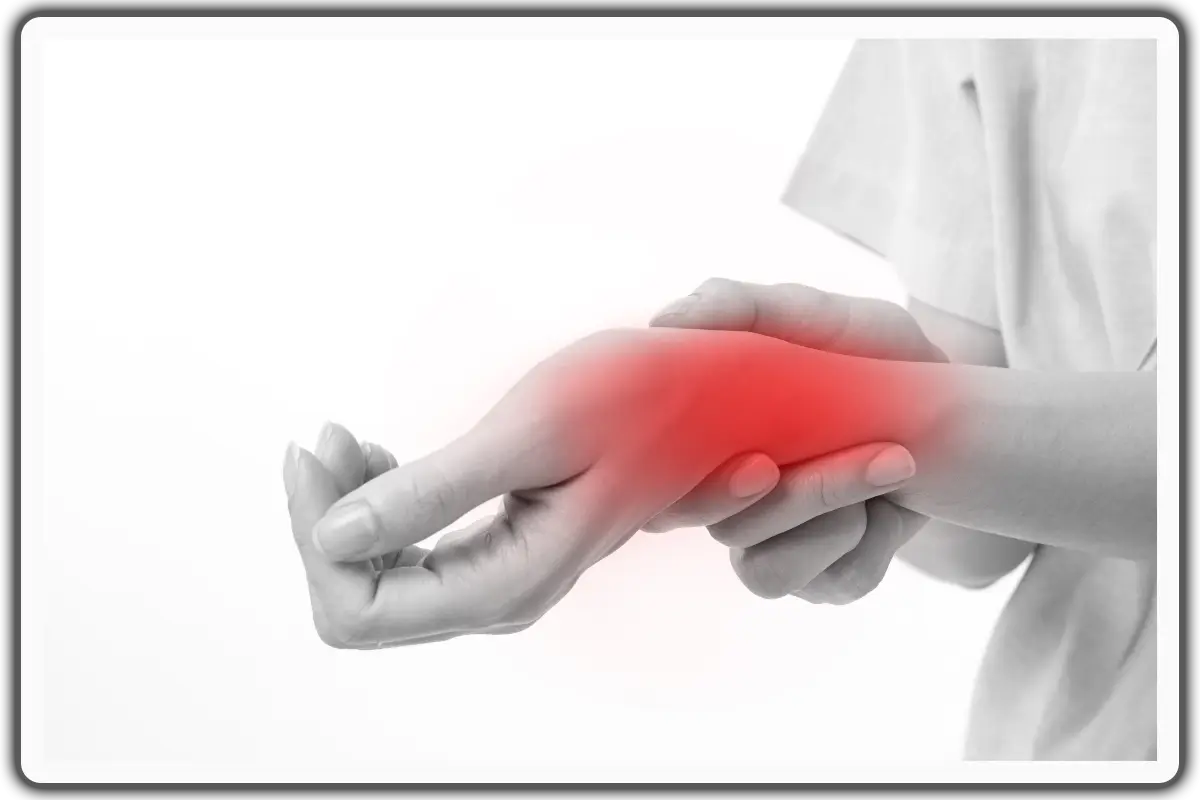
Understanding different wrist conditions can give you better insights into why you might be experiencing pain.
- Carpal Tunnel Syndrome: Pain in the hand and arm, numbness, and tingling are common symptoms of the median nerve being compressed at the wrist.
- De Quervain's Tenosynovitis: Pain and swelling result from the inflammation of the tendons on the side of the wrist where the thumb is located.
- Ganglion Cyst: Fluid-filled cysts can develop along the tendons or joints of the wrists or hands.
- Wrist Tendonitis: Inflammation of the tendons within the wrist leads to pain and difficulty moving.
- Wrist Bursitis: Inflammation of the bursae in the wrist causes pain and swelling.
- Kienbock's Disease: Pain and stiffness result from the deprivation of blood supply to a small bone within the wrist.
- Ulnar Tunnel Syndrome manifests when the ulnar nerve at the wrist is compressed, leading to discomfort and a loss of sensation in the hand.
- Scaphoid Fracture: If not treated, a break in the scaphoid bone can lead to pain and potential long-term issues.
- Wrist Sprain: Stretching or tearing of the ligaments in the wrist, causing pain and limited movement.
- Dupuytren's Contracture: Affects the palm and fingers but can extend to the wrist, causing the fingers to curl inward.
- Triangular Fibrocartilage Complex (TFCC) Injury: Damage to the TFCC, causing pain and instability in the wrist.
If you're experiencing wrist pain, it could be due to one of these conditions. Identifying the specific cause is crucial for effective treatment and management.
Common Causes of Wrist Pain in Weightlifters
Incorrect Technique
If a weightlifter doesn't adhere to the proper lifting technique, it can exert excessive stress on the wrist.
American Council on Exercise (ACE) - Relevant Quote: "Poor form, especially with overhead movements like shoulder presses [¹], can put unnecessary strain on the wrists and lead to injury over time.
Overuse
Repeatedly lifting weights without adequate wrist rest can cause pain, a phenomenon known as overuse.
Lack of Support
Not using wrist support, such as wraps or gloves, during intense lifts can lead to issues akin to playing a sport without appropriate gear.
"Proper use of wrist supports, such as wraps or guards, can help prevent wrist injuries during weightlifting and other sports activities." Summary: According to UW Medicine, using appropriate wrist support, such as wraps or guards, can help prevent wrist injuries during weightlifting and other sports activities [²] that place stress on the wrist.
Repetitive Motions
Performing the same wrist movements repeatedly, especially with heavy weights, can lead to strain and discomfort, emphasizing the need for varied routines.
National Institute for Occupational Safety and Health (NIOSH) - Relevant Quote: "Repetitive, forceful, or prolonged exertions can lead to fatigue and strain in the wrist muscles and tendons, increasing the risk of musculoskeletal disorders [³]."
Identifying and addressing the underlying causes is crucial to maintaining healthy, pain-free wrists. Understanding what's wrong allows you to correct it and safeguard your wrists during exercise.
Essential Exercises for Wrist Pain
1. Alphabet Warm-up
Begin in an upright standing position. Extend your arms in front of your body at shoulder height with your palms curled in a loose fist. Move your hands, tracing the alphabet letters (A, B, C, D, etc.) in a smooth, controlled movement. Try to do the full range of motion that your wrists can do.
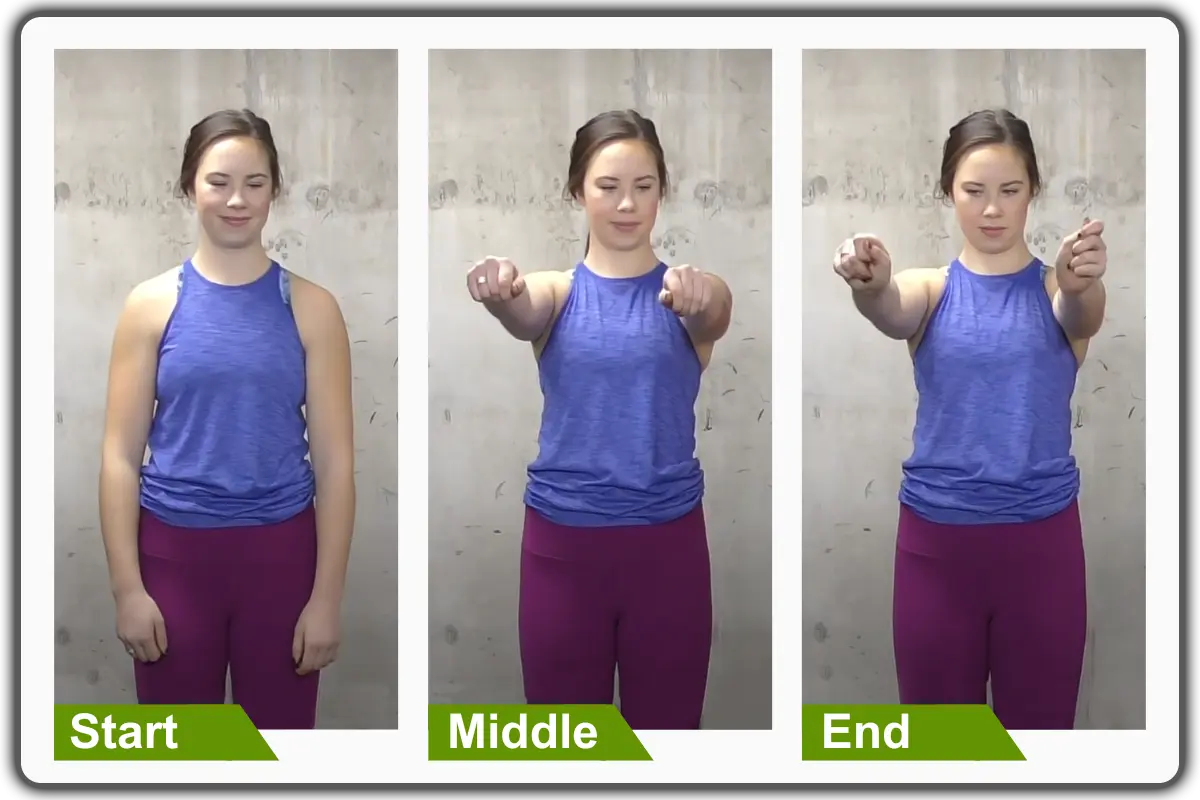
Alphabet Warm-up
Perform these movements for about 10 seconds. It is not necessary to go through the entire alphabet. Do the movement for 10 seconds in a full range of motion because the end ranges are the most important.
Those end ranges are often stiff, which can affect our ability to do weight training. This can also lead to wrist pain, so it is important to loosen them up.
2. Exterior Wrist Rotations
You can perform this exercise in either standing or sitting position. Curl your right hand into a tight fist and bend your elbow, bringing your right arm to a 90-degree angle in front of your body with your palm facing the ceiling. Support your forearm with your other hand if needed. Move through the outside direction with very small movement. Relax for a while and repeat the exercise. Return to the starting position and repeat the movement
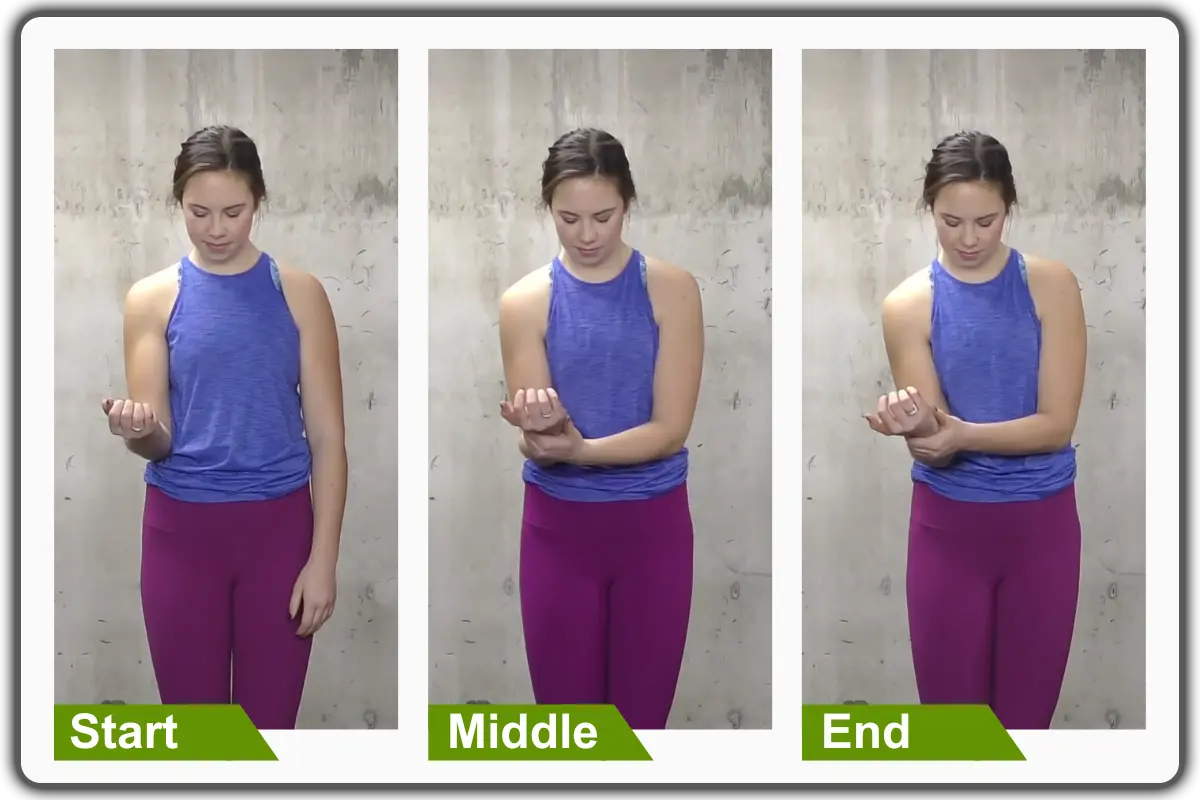
Exterior Wrist Rotations
3. Banded Wrist Extensions
For this exercise, utilize a resistance band or anything that you can grab onto that creates resistance.
You can perform this exercise in either standing or sitting position. Bend your elbow, bringing your right arm to a 90-degree angle in front of your body with your palm facing to the side. Grab the middle of the band, then slowly pull the band with your hand while keeping your forearm in the middle position. Return to the starting position and repeat the movement.
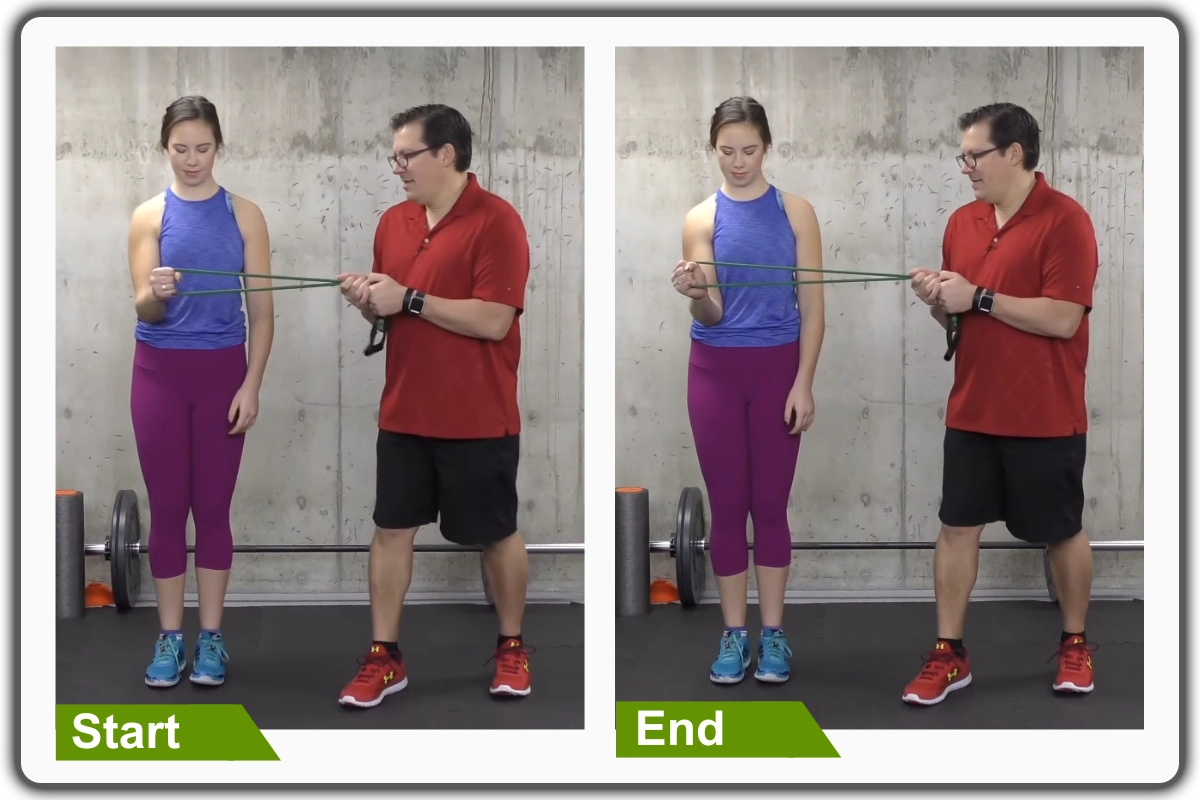
Banded Wrist Extensions
4. Fingertip Pushups From the Wall
Stand in an upright position. Place both hands up against the wall at shoulder height, relaxing the elbows. Close your hands slowly by exerting pressure through your fingertips, mimicking the motion of a push-up. Repeat the movement as needed.
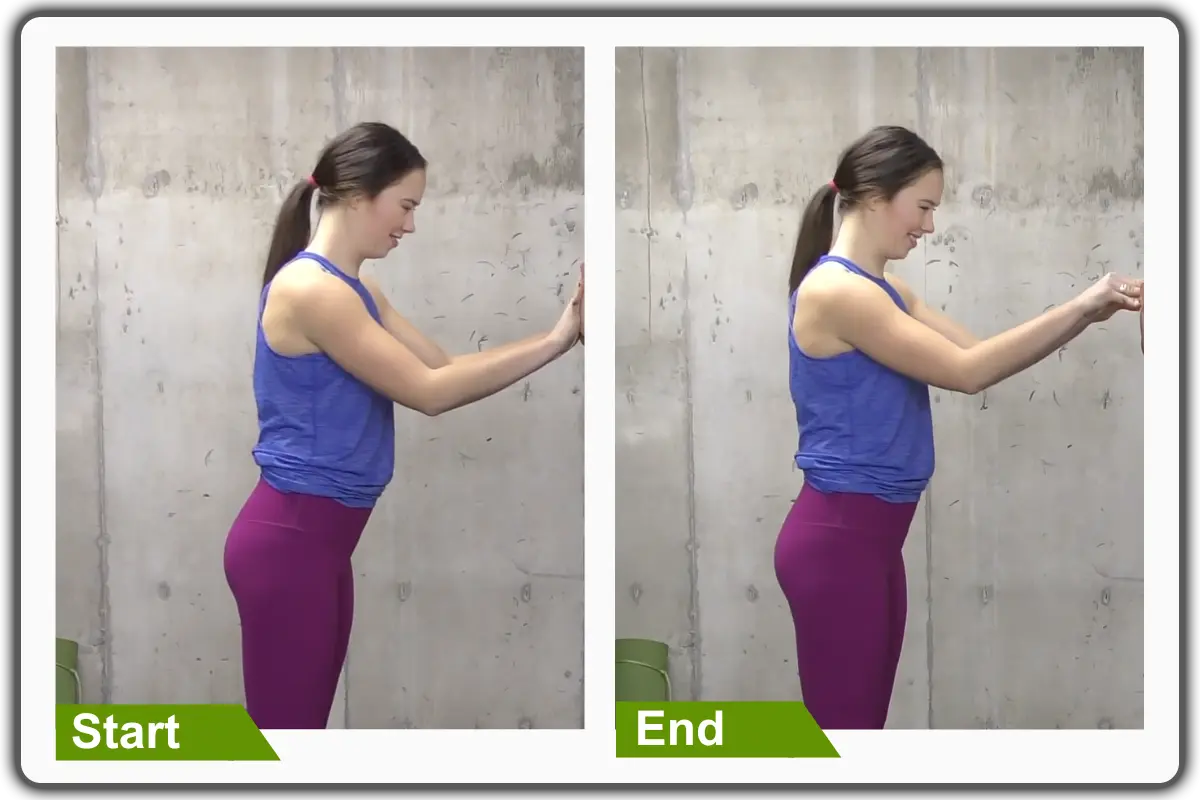
Fingertip Pushups From the Wall
5. Wrist and Finger Extensors Stretch
Begin in an upright standing position with your feet shoulder-width apart, maintaining a good alignment with your head, shoulders, hips, and legs. Extend one arm in front of your body at shoulder height. Looking for a light stretch in the forearm area, lower your hand down so that your palm faces your body and your fingers point toward the floor. Pull one finger at a time using your opposite hand, feeling a stretch along the underside of your forearm. Hold each position for 15-30 seconds. Relax and repeat the movement on the opposite side. Perform the movement for 2 to 3 repetitions on each arm.
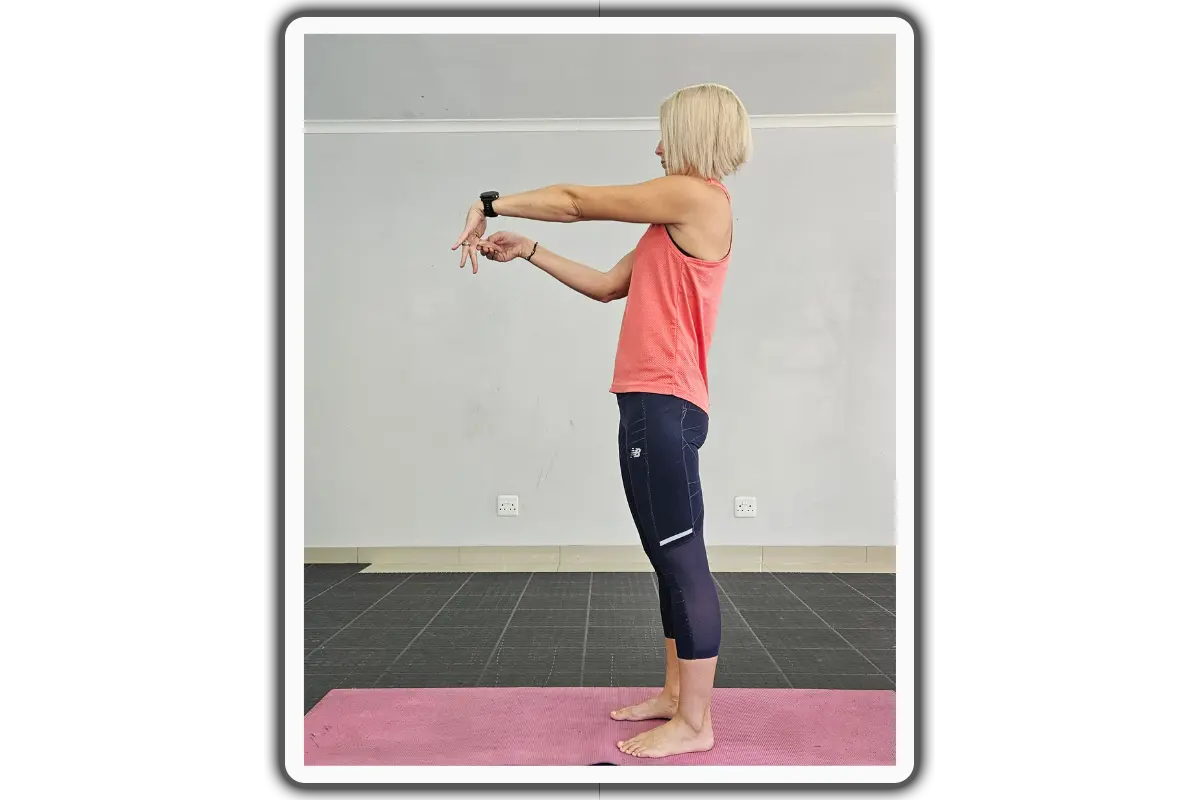
Wrist and Finger Extensors Stretch
6. Wrist Extensor Stretch
Begin in an upright standing position with your feet shoulder-width apart, maintaining a good alignment with your head, shoulders, hips, and legs. Extend one arm in front of your body at shoulder height. Looking for a light stretch in the forearm area, lower your hand down so that your palm faces away from your body and your fingers point toward the floor. Using your opposite hand, push the front of your hand to intensify the stretch. Hold this position for 15 to 30 seconds, feeling a gentle stretch without pain. Perform this movement for 2 to 3 repetitions on each wrist.
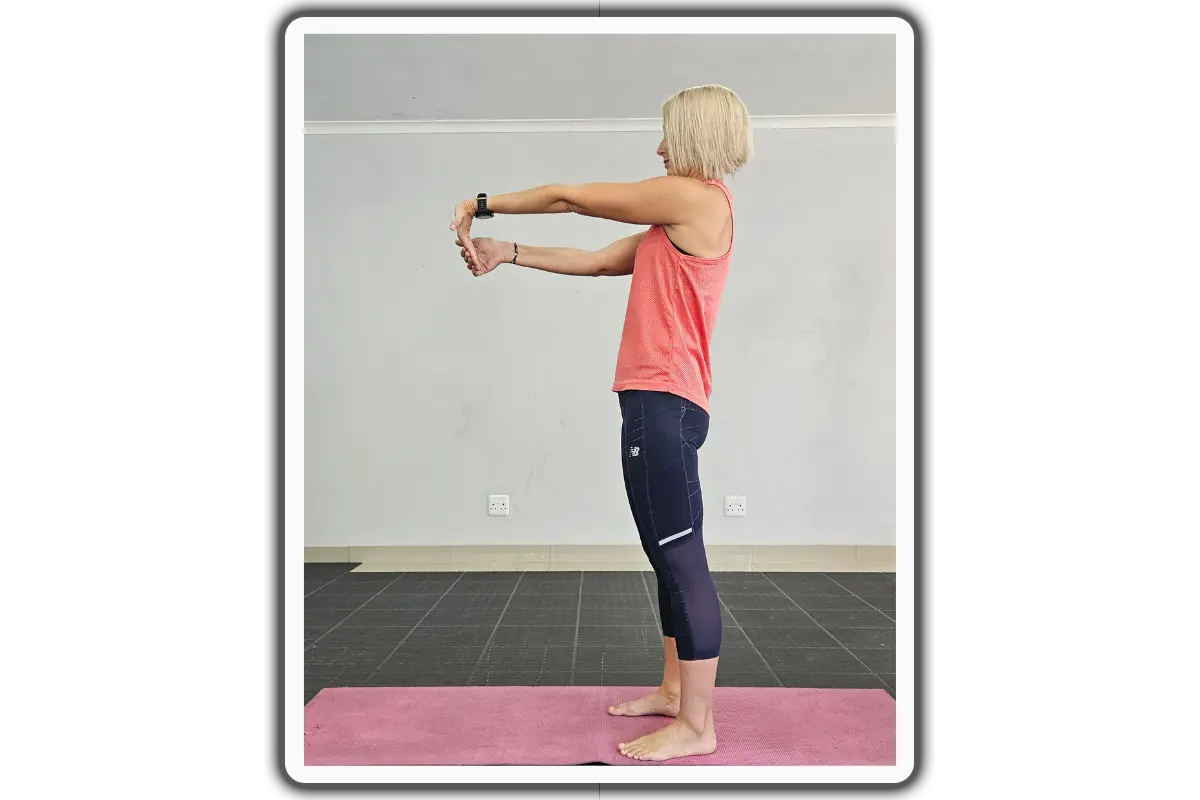
Wrist Extensor Stretch
7. Wrist Flexion
Begin in an upright sitting position with your feet flat on the floor, maintaining good alignment with your head, shoulders, and hips. Hold a dumbbell in one hand with your palm facing upward. Hinge through your hips to lean your upper body forward, resting your forearm on your thigh. Curl your hand through your wrist, bringing the dumbbell towards your forearm. Straighten your wrist to return to the starting position and repeat the movement. Perform the movement for 2 to 3 sets of 10 to 15 repetitions on each side.
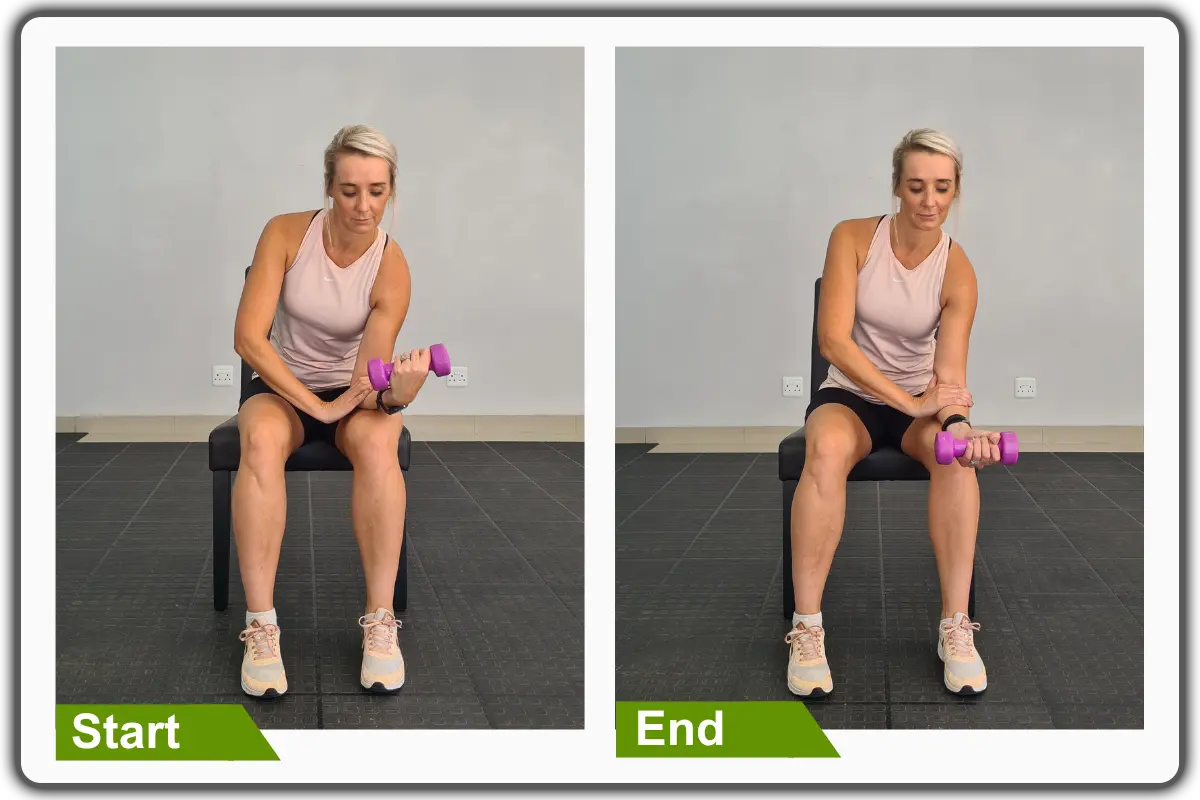
Wrist Flexion
Give these wrist exercises a go to help fix wrist pain from weightlifting.
Proper Wrist Support and Equipment for Weightlifters
Investing in proper wrist support and equipment is essential for weightlifters looking to prevent or alleviate wrist pain. Here are some options to consider:
1. Wrist Wraps
Wrist wraps offer extra stability and support for your wrists when lifting heavy weights. They help maintain proper alignment and reduce the risk of injury. When choosing wrist wraps, opt for adjustable ones with a snug fit.
2. Lifting Straps
Lifting straps can be beneficial for exercises that strain your grip excessively, such as wrist stretches such as deadlifts or pull-ups. Using lifting straps, you can take some of the load off your wrists and focus on the targeted muscles instead.
3. Weightlifting Gloves
While not directly targeting wrist pain, weightlifting gloves can provide additional padding and grip support, reducing the strain on your wrists. They can also prevent blisters and calluses, improving overall comfort during your workouts.
Remember that wrist support and equipment should not substitute for proper form and technique. They should complement your training and provide additional support when needed.
Tips for Preventing Wrist Pain in Weightlifting
Prevention is always better than cure. By following these guidelines, you can greatly diminish the likelihood of serious wrist joint pain and injuries during weightlifting:
Warm-up and Cool-down
Begin each weightlifting session with a thorough warm-up, incorporating dynamic stretches and mobility exercises tailored to your wrists. Similarly, conclude your session with static stretches to uphold flexibility and facilitate recovery.
Progress Gradually
Avoid the temptation to increase weight too quickly. Slowly raise the level of demand and vigor in your exercise sessions to allow your wrists to adapt and strengthen over time.
Focus on Technique
Pay close attention to your form and technique during weightlifting exercises. Proper alignment and execution will reduce the strain on your wrists and improve your overall performance.
Listen to Your Body
If you experience any pain or discomfort in your wrists, don't ignore it. Take a break, allow your wrists to rest and recover, and seek appropriate medical advice.
5. Stay Hydrated
Adequate hydration is essential for sustaining optimal health and flexibility of your joints, including your wrists. Drink plenty of water throughout the day to keep your body well-hydrated.
While the exercises and tips provided can significantly reduce wrist pain, there are instances when professional intervention is necessary.
- Persistent Pain: If the pain doesn't improve with rest and home treatments after a few days, it's time to see a doctor.
- Severe Pain: Intense pain that doesn't subside, especially if it disrupts your everyday routines or affects your sleep pattern.
- Decreased Mobility: Difficulty or inability to move your wrist normally, especially if it affects your grip strength or the range of motion.
- Visible Changes: Noticeable swelling, redness, deformity, or if the wrist area feels unusually warm to the touch.
- After an Injury: If the wrist pain follows a fall, a hit, or any sudden impact and is severe or swelling.
- Numbness or Tingling: Persistent or severe numbness, tingling, or weakness in the wrist or hand, especially if it's affecting your ability to hold objects.
- Signs of Infection: If there are signs of infection, such as fever, red streaks, or pus around the wrist area.
- Nighttime Pain: Pain that wakes you up at night or significantly worsens during rest periods.
- Lack of Improvement: If there's no improvement despite using wrist supports or modifying your activities.
- Recurring Pain: Pain that keeps returning, even if it goes away for a while, especially if it worsens gradually.
Signs Your Wrist Pain May Be Serious
Your wrist pain may be serious and warrant immediate medical attention if you notice any of the following signs:
- Intense Pain: Pain that is severe and limits your ability to use your hand or wrist.
- Swelling or Bruising: Significant swelling or bruising around the wrist, especially if it develops rapidly.
- Deformity: Any visible deformity or unnatural wrist angle suggesting a possible fracture or dislocation.
- Loss of Function: Difficulty or inability to move your wrist or fingers or significantly decrease grip strength.
- Numbness or Tingling: You may experience persistent numbness, tingling, or a "pins and needles" sensation in your hand or fingers.
- Unrelieved Pain: Pain that does not improve with rest, ice, compression, or elevation.
- Pain That Worsens: Pain that progressively worsens or doesn't improve with standard care measures.
- Night Pain: Pain that is severe enough to disturb your sleep or is significantly worse at night.
- Fever or Redness: Signs of infection include increased warmth, redness, fever, or a feeling of heat in the affected area.
- Previous Injury: If you've recently injured your wrist and the symptoms worsen instead of improving.
Learn to recognize the signs that indicate your wrist pain might require medical attention. This awareness can prevent further injury and ensure timely and appropriate treatment.
Treatment Options Beyond Exercises
Apart from physical exercises, various treatment options are available for wrist pain, contingent upon the root cause and extent of the condition:
1. Medications
- Pain Relievers: Ibuprofen or acetaminophen, available without a prescription, can alleviate pain and reduce inflammation.
- Topical Creams: Anti-inflammatory medications or analgesics in creams or gels can be directly administered to the wrist.
- Prescription Medications: Your doctor might prescribe stronger pain relievers or anti-inflammatory drugs in more severe cases.
2. Bracing or Splinting
A wrist brace or splint can immobilize the wrist, allowing it to rest and heal while reducing pain and preventing further injury.
3. Physical Therapy
A physical therapist-tailored program can enhance wrist strength and stability, optimize functionality, and alleviate discomfort.
4. Corticosteroid Injections
Injecting corticosteroids into the wrist can relieve inflammation and pain, especially in conditions like tendonitis or arthritis.
5. Occupational Therapy
Occupational therapists can teach you how to modify your daily activities and workplace ergonomics to prevent wrist strain and promote healing.
6. Alternative Therapies
Some individuals may find relief through treatments like acupuncture, massage, or chiropractic care.
7. Surgery
In cases where conservative treatments don't provide relief, or if there's a structural problem in the wrist, surgery might be necessary.
8. Injection Therapy
For certain conditions, injecting platelet-rich plasma (PRP) or other substances may promote healing and reduce pain.
Changing certain activities or adjusting how you perform tasks can help alleviate wrist pain and prevent future injuries.
10. Heat and Cold Therapy
Ice packs have the potential to alleviate acute inflammation and diminish pain sensations, whereas heat therapy can promote muscle relaxation and enhance blood circulation.
It is crucial to consult with a healthcare expert to devise a customized treatment strategy tailored to your specific wrist condition.
Conclusion: Enhancing Wrist Strength and Resilience
Knowing why wrist pain happens and adding the right exercises and safety steps to your workout can improve your weightlifting sessions and avoid wrist pain. It's really important always to use the correct way of lifting, wear the right protective gear, and pay attention to what your body is telling you. These steps are essential for keeping your wrists in good shape.
Moreover, incorporating an ergonomic keyboard into your daily routine can help maintain wrist health, especially if you spend significant time typing or gaming, which complements your fitness goals by reducing undue stress on your wrists.
If you keep having wrist pain, getting advice from a doctor or a physical therapist is very important. This way, you can prevent more serious injuries and get back to lifting weights safely and effectively. Taking these proactive steps enhances your performance and ensures that your weightlifting journey is both enjoyable and sustainable in the long run.
References
1. http://www.acefitness.org/education-and-resources/lifestyle/blog/6593/proper-form-for-weight-lifting/
2. https://orthop.washington.edu/patient-care/articles/sports/common-sports-injuries-and-sports-injury-prevention-tips.html
3. Preventing Occupational Exposure to Antineoplastic (2016-161) | NIOSH | CDC
